OPEN: A New Estimation of Global Ocean Heat Content for Upper 2000 Meters from Remote Sensing Data
Abstract
1. Introduction
2. Data
3. Method
3.1. Artificial Neural Network
3.2. Experimental Design
4. Results and Discussion
4.1. Optimization of the Network Structure
4.2. Optimization of Feature Combinations
4.3. Data Reconstruction
5. Summary and Conclusions
Supplementary Materials
Author Contributions
Funding
Acknowledgments
Conflicts of Interest
References
- Trenberth, K.E.; Fasullo, J.T.; Balmaseda, M.A. Earth’s Energy Imbalance. J. Clim. 2014, 27, 3129–3144. [Google Scholar] [CrossRef]
- Meyssignac, B.; Boyer, T.; Zhao, Z.; Hakuba, M.Z.; Landerer, F.W.; Stammer, D.; Köhl, A.; Kato, S.; L’Ecuyer, T.; Ablain, M.; et al. Measuring Global Ocean Heat Content to Estimate the Earth Energy Imbalance. Front. Mar. Sci. 2019, 6, 432. [Google Scholar] [CrossRef]
- Von Schuckmann, K.; Palmer, M.D.; Trenberth, K.E.; Cazenave, A.; Chambers, D.; Champollion, N.; Hansen, J.; Josey, S.A.; Loeb, N.; Mathieu, P.P.; et al. An imperative to monitor Earth’s energy imbalance. Nat. Clim. Chang. 2016, 6, 138–144. [Google Scholar] [CrossRef]
- Balmaseda, M.A.; Trenberth, K.E.; Källén, E. Distinctive climate signals in reanalysis of global ocean heat content. Geophys. Res. Lett. 2013, 40, 1754–1759. [Google Scholar] [CrossRef]
- Bindoff, N.L.; Willebrand, J.; Artale, V.; Cazenave, A.; Gregory, J.M.; Gulev, S.; Hanawa, K.; Le Quere, C.; Levitus, S.; Nojiri, Y.; et al. Observations: Oceanic climate change and sea level. In Climate Change 2007: The Physical Science Basis; Cambridge University Press: Cambridge, UK, 2007. [Google Scholar]
- Antonov, J.I.; Levitus, S.; Boyer, T.P. Climatological annual cycle of ocean heat content. Geophys. Res. Lett. 2004, 31, L04304. [Google Scholar] [CrossRef]
- Levitus, S.; Antonov, J.I.; Wang, J.; Delworth, T.L.; Dixon, K.W.; Broccoli, A.J. Anthropogenic Warming of Earth’s Climate System. Science 2001, 292, 267–270. [Google Scholar] [CrossRef] [PubMed]
- IPCC. Observations: Ocean Pages. In Climate Change 2013—The Physical Science Basis: Working Group I Contribution to the Fifth Assessment Report of the Intergovernmental Panel on Climate Change; Cambridge University Press: Cambridge, UK, 2014; pp. 255–316. [Google Scholar] [CrossRef]
- Rebert, J.P.; Donguy, J.R.; Eldin, G.; Wyrtki, K. Relations between sea-level, thermocline depth, heat-content, and dynamic height in the tropical pacific-ocean. J. Geophys. Res. Oceans 1985, 90, 1719–1725. [Google Scholar] [CrossRef]
- Chen, J.L.; Shum, C.K.; Wilson, C.R.; Chambers, D.P.; Tapley, B.D. Seasonal sea level change from TOPEX/Poseidon observation and thermal contribution. J. Geod. 2000, 73, 638–647. [Google Scholar] [CrossRef]
- Cheng, L.J.; Abraham, J.; Zhu, J.; Trenberth, K.E.; Fasullo, J.; Boyer, T.; Locarnini, R.; Zhang, B.; Yu, F.J.; Wan, L.Y.; et al. Record-Setting Ocean Warmth Continued in 2019. Adv. Atmos. Sci. 2020, 37, 137–142. [Google Scholar] [CrossRef]
- Klemas, V.; Yan, X.H. Subsurface and deeper ocean remote sensing from satellites: An overview and new results. Prog. Oceanogr. 2014, 122, 1–9. [Google Scholar] [CrossRef]
- Akbari, E.; Alavipanah, S.K.; Jeihouni, M.; Hajeb, M.; Haase, D.; Alavipanah, S. A Review of Ocean/Sea Subsurface Water Temperature Studies from Remote Sensing and Non-Remote Sensing Methods. Water 2017, 9, 936. [Google Scholar] [CrossRef]
- Su, H.; Wu, X.; Yan, X.-H.; Kidwell, A. Estimation of subsurface temperature anomaly in the Indian Ocean during recent global surface warming hiatus from satellite measurements: A support vector machine approach. Remote Sens. Environ. 2015, 160, 63–71. [Google Scholar] [CrossRef]
- Yan, X.H.; Schubel, J.R.; Pritchard, D.W. Ocean upper mixed layer depth determination by the use of satellite data. Remote Sens. Environ. 1990, 32, 55–74. [Google Scholar] [CrossRef]
- Chu, P.C.; Fan, C.; Liu, W.T. Determination of Vertical Thermal Structure from Sea Surface Temperature. J. Atmos. Ocean. Technol. 2000, 17, 971–979. [Google Scholar] [CrossRef]
- Yan, X.H.; Okubo, A.; Schubel, J.R.; Pritchard, D.W. An analytical model for remote-sensing determination of the mixed layer depth. Deep Sea Res. Part A Oceanogr. Res. Pap. 1991, 38, 267–287. [Google Scholar] [CrossRef]
- Reichstein, M.; Camps-Valls, G.; Stevens, B.; Jung, M.; Denzler, J.; Carvalhais, N. Deep learning and process understanding for data-driven Earth system science. Nature 2019, 566, 195–204. [Google Scholar] [CrossRef]
- Ali, M.M.; Swain, D.; Weller, R.A. Estimation of ocean subsurface thermal structure from surface parameters: A neural network approach. Geophys. Res. Lett. 2004, 31, L20308. [Google Scholar] [CrossRef]
- Jain, S.; Ali, M.M. Estimation of Sound Speed Profiles Using Artificial Neural Networks. IEEE Geosci. Remote Sens. Lett. 2006, 3, 467–470. [Google Scholar] [CrossRef]
- Swain, D.; Ali, M.M.; Weller, R.A. Estimation of mixed-layer depth from surface parameters. J. Mar. Res. 2006, 64, 745–758. [Google Scholar] [CrossRef]
- Jain, S.; Ali, M.M.; Sen, P.N. Estimation of sonic layer depth from surface parameters. Geophys. Res. Lett. 2007, 34, L17602. [Google Scholar] [CrossRef]
- Jagadeesh, P.S.V.; Kumar, M.S.; Ali, M.M. Estimation of Heat Content and Mean Temperature of Different Ocean Layers. IEEE J. Sel. Top. Appl. Earth Obs. Remote Sens. 2015, 8, 1251–1255. [Google Scholar] [CrossRef]
- Guinehut, S.; Dhomps, A.L.; Larnicol, G.; Le Traon, P.Y. High resolution 3-D temperature and salinity fields derived from in situ and satellite observations. Ocean Sci. 2012, 8, 845–857. [Google Scholar] [CrossRef]
- Lu, W.; Su, H.; Yang, X.; Yan, X.-H. Subsurface temperature estimation from remote sensing data using a clustering-neural network method. Remote Sens. Environ. 2019, 229, 213–222. [Google Scholar] [CrossRef]
- Charantonis, A.A.; Badran, F.; Thiria, S. Retrieving the evolution of vertical profiles of Chlorophyll-a from satellite observations using Hidden Markov Models and Self-Organizing Topological Maps. Remote Sens. Environ. 2015, 163, 229–239. [Google Scholar] [CrossRef]
- Friedrich, T.; Oschlies, A. Neural network-based estimates of North Atlantic surface pCO2 from satellite data: A methodological study. J. Geophys. Res. Oceans 2009, 114, C03020. [Google Scholar] [CrossRef]
- Garcia-Gorriz, E.; Garcia-Sanchez, J. Prediction of sea surface temperatures in the western Mediterranean Sea by neural networks using satellite observations. Geophys. Res. Lett. 2007, 34, L11603. [Google Scholar] [CrossRef]
- Zanna, L.; Khatiwala, S.; Gregory, J.M.; Ison, J.; Heimbach, P. Global reconstruction of historical ocean heat storage and transport. Proc. Natl. Acad. Sci. USA 2019, 116, 1126–1131. [Google Scholar] [CrossRef]
- Roemmich, D.; Gilson, J. The 2004–2008 mean and annual cycle of temperature, salinity, and steric height in the global ocean from the Argo Program. Prog. Oceanogr. 2009, 82, 81–100. [Google Scholar] [CrossRef]
- Su, H.; Wu, X.B.; Lu, W.F.; Zhang, W.W.; Yan, X.H. Inconsistent Subsurface and Deeper Ocean Warming Signals During Recent Global Warming and Hiatus. J. Geophys. Res. Oceans 2017, 122, 8182–8195. [Google Scholar] [CrossRef]
- Yan, X.-H.; Boyer, T.; Trenberth, K.; Karl, T.R.; Xie, S.-P.; Nieves, V.; Tung, K.-K.; Roemmich, D. The global warming hiatus: Slowdown or redistribution? Earth’s Future 2016, 4, 472–482. [Google Scholar] [CrossRef]
- Chen, X.Y.; Tung, K.K. Varying planetary heat sink led to global-warming slowdown and acceleration. Science 2014, 345, 897–903. [Google Scholar] [CrossRef] [PubMed]
- Lee, S.-K.; Park, W.; Baringer, M.O.; Gordon, A.L.; Huber, B.; Liu, Y. Pacific origin of the abrupt increase in Indian Ocean heat content during the warming hiatus. Nat. Geosci. 2015, 8, 445–449. [Google Scholar] [CrossRef]
- Cheng, L.; Trenberth, K.E.; Fasullo, J.; Boyer, T.; Abraham, J.; Zhu, J. Improved estimates of ocean heat content from 1960 to 2015. Sci. Adv. 2017, 3, e1601545. [Google Scholar] [CrossRef] [PubMed]
- Levitus, S.; Antonov, J.I.; Boyer, T.P.; Baranova, O.K.; Garcia, H.E.; Locarnini, R.A.; Mishonov, A.V.; Reagan, J.R.; Seidov, D.; Yarosh, E.S.; et al. World ocean heat content and thermosteric sea level change (0–2000 m), 1955–2010. Geophys. Res. Lett. 2012, 39, L10603. [Google Scholar] [CrossRef]
- Good, S.A.; Martin, M.J.; Rayner, N.A. EN4: Quality controlled ocean temperature and salinity profiles and monthly objective analyses with uncertainty estimates. J. Geophys. Res. Oceans 2013, 118, 6704–6716. [Google Scholar] [CrossRef]
- Gouretski, V.; Reseghetti, F. On depth and temperature biases in bathythermograph data: Development of a new correction scheme based on analysis of a global ocean database. Deep Sea Res. Part I Oceanogr. Res. Pap. 2010, 57, 812–833. [Google Scholar] [CrossRef]
- Foresee, F.D.; Hagan, M.T. Gauss-Newton Approximation to Bayesian Learning. In Proceedings of the International Conference on Neural Networks, Houston, TX, USA, 12 June 1997. [Google Scholar]
- Su, H.; Yang, X.; Lu, W.; Yan, X.-H. Estimating Subsurface Thermohaline Structure of the Global Ocean Using Surface Remote Sensing Observations. Remote Sens. 2019, 11, 1598. [Google Scholar] [CrossRef]
- Beal, L.M.; De Ruijter, W.P.; Biastoch, A.; Zahn, R. On the role of the Agulhas system in ocean circulation and climate. Nature 2011, 472, 429–436. [Google Scholar] [CrossRef]
- Cheng, L.J.; Abraham, J.; Hausfather, Z.; Trenberth, K.E. How fast are the oceans warming? Science 2019, 363, 128–129. [Google Scholar] [CrossRef]
- Mantua, N.J.; Hare, S.R.; Zhang, Y.; Wallace, J.M.; Francis, R.C. A Pacific interdecadal climate oscillation with impacts on salmon production. Bull. Am. Meteorol. Soc. 1997, 78, 1069–1080. [Google Scholar] [CrossRef]
- Levitus, S.; Antonov, J.I.; Boyer, T.P.; Locarnini, R.A.; Garcia, H.E.; Mishonov, A.V. Global ocean heat content 1955–2008 in light of recently revealed instrumentation problems. Geophys. Res. Lett. 2009, 36, L07608. [Google Scholar] [CrossRef]
- Cheng, L.; Abraham, J.; Goni, G.; Boyer, T.; Wijffels, S.; Cowley, R.; Gouretski, V.; Reseghetti, F.; Kizu, S.; Dong, S.; et al. XBT Science: Assessment of Instrumental Biases and Errors. Bull. Am. Meteorol. Soc. 2016, 97, 924–933. [Google Scholar] [CrossRef]
- Jeong, Y.; Hwang, J.; Park, J.; Jang, C.J.; Jo, Y.H. Reconstructed 3-D Ocean Temperature Derived from Remotely Sensed Sea Surface Measurements for Mixed Layer Depth Analysis. Remote Sens. 2019, 11, 3018. [Google Scholar] [CrossRef]
- Resplandy, L.; Keeling, R.F.; Eddebbar, Y.; Brooks, M.; Wang, R.; Bopp, L.; Long, M.C.; Dunne, J.P.; Koeve, W.; Oschlies, A. Quantification of ocean heat uptake from changes in atmospheric O2 and CO2 composition. Sci. Rep. 2019, 9, 20244. [Google Scholar] [CrossRef]
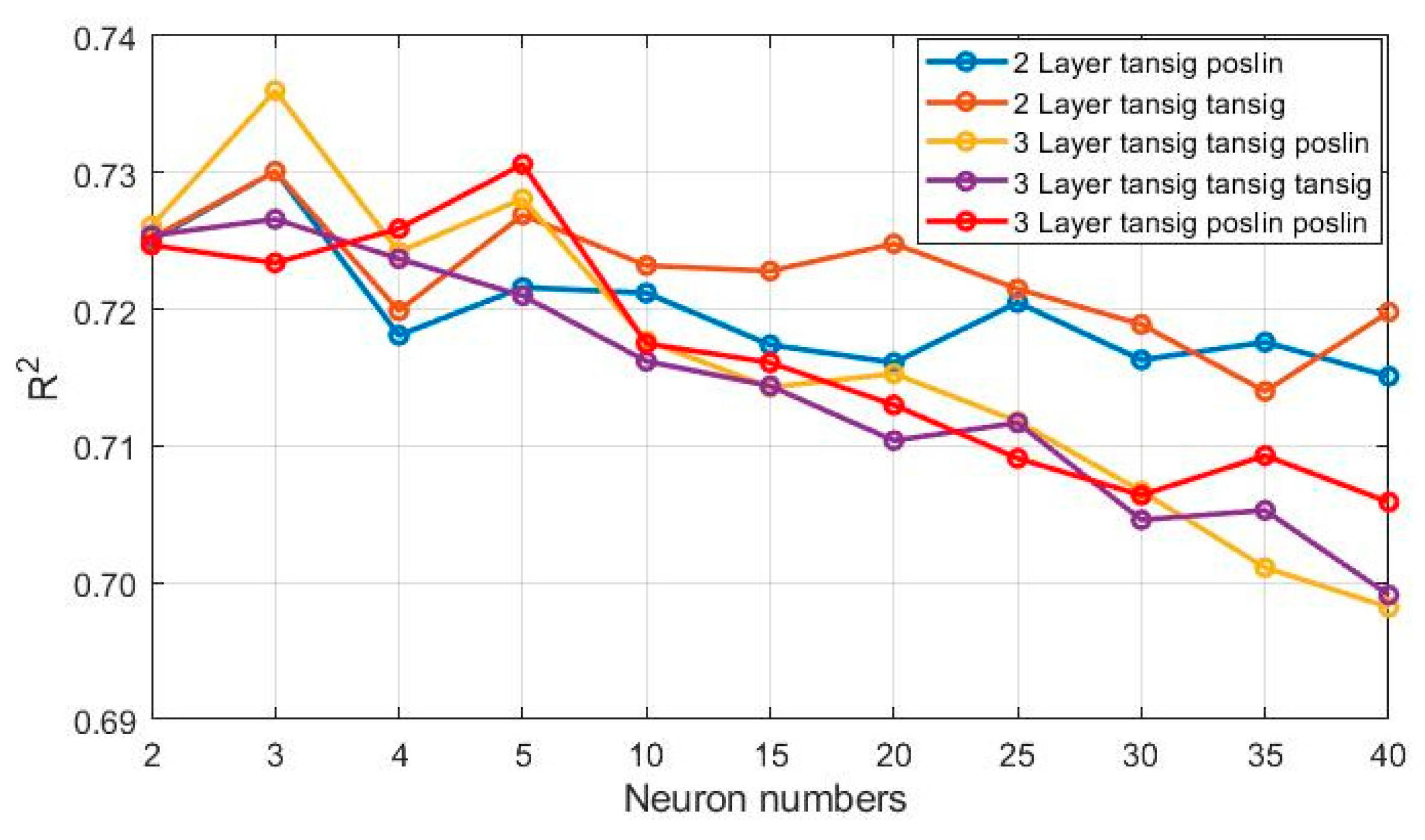
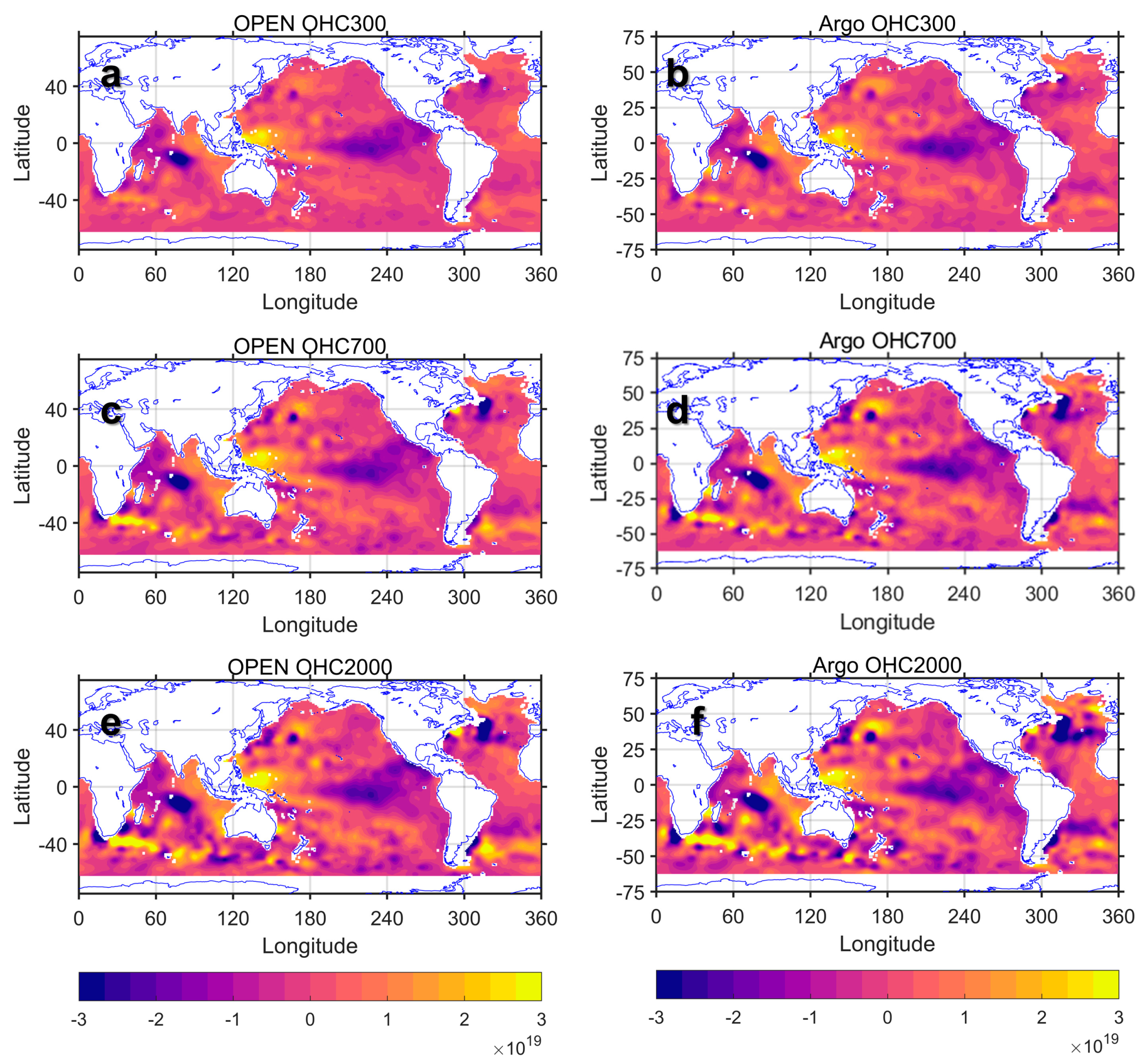
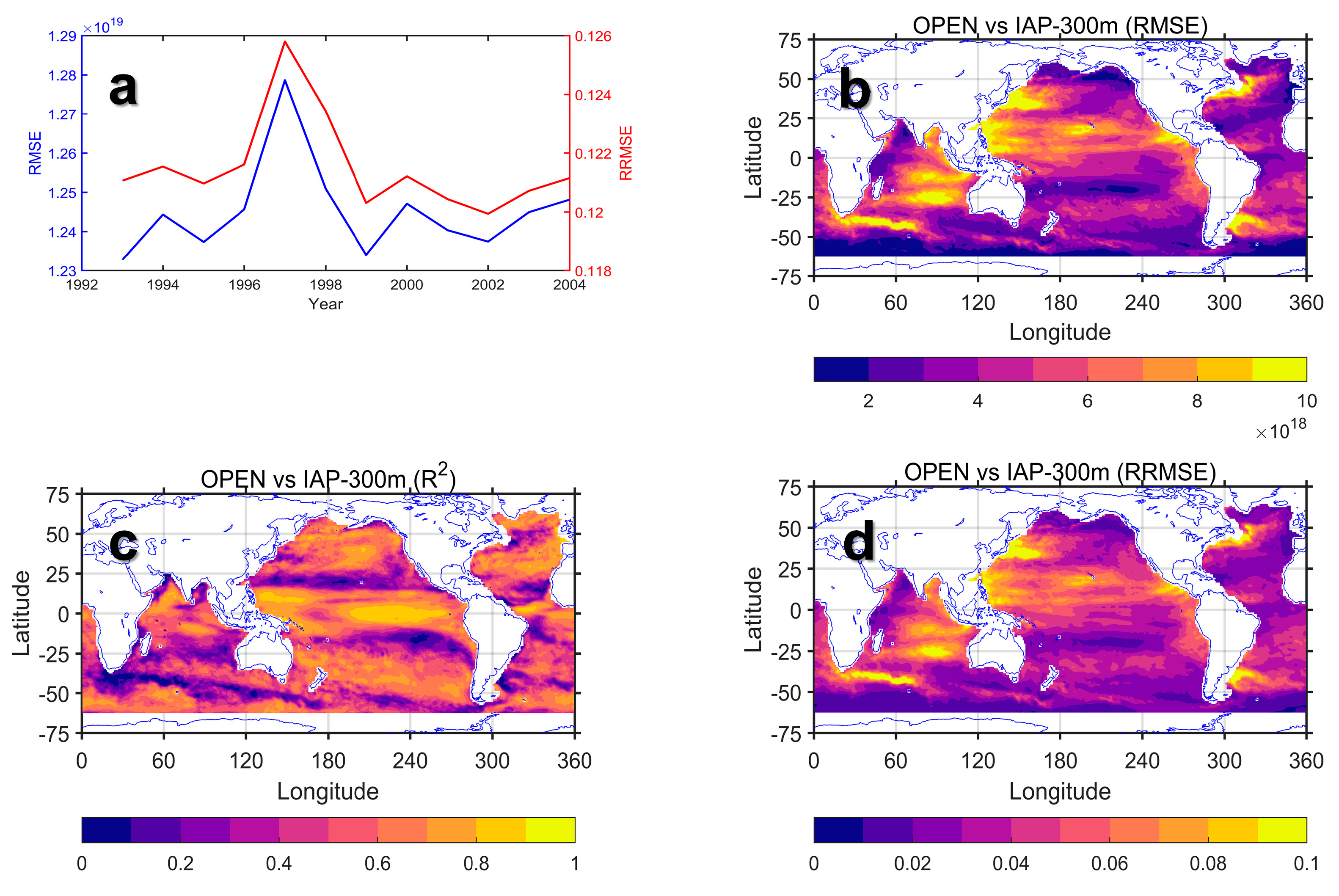
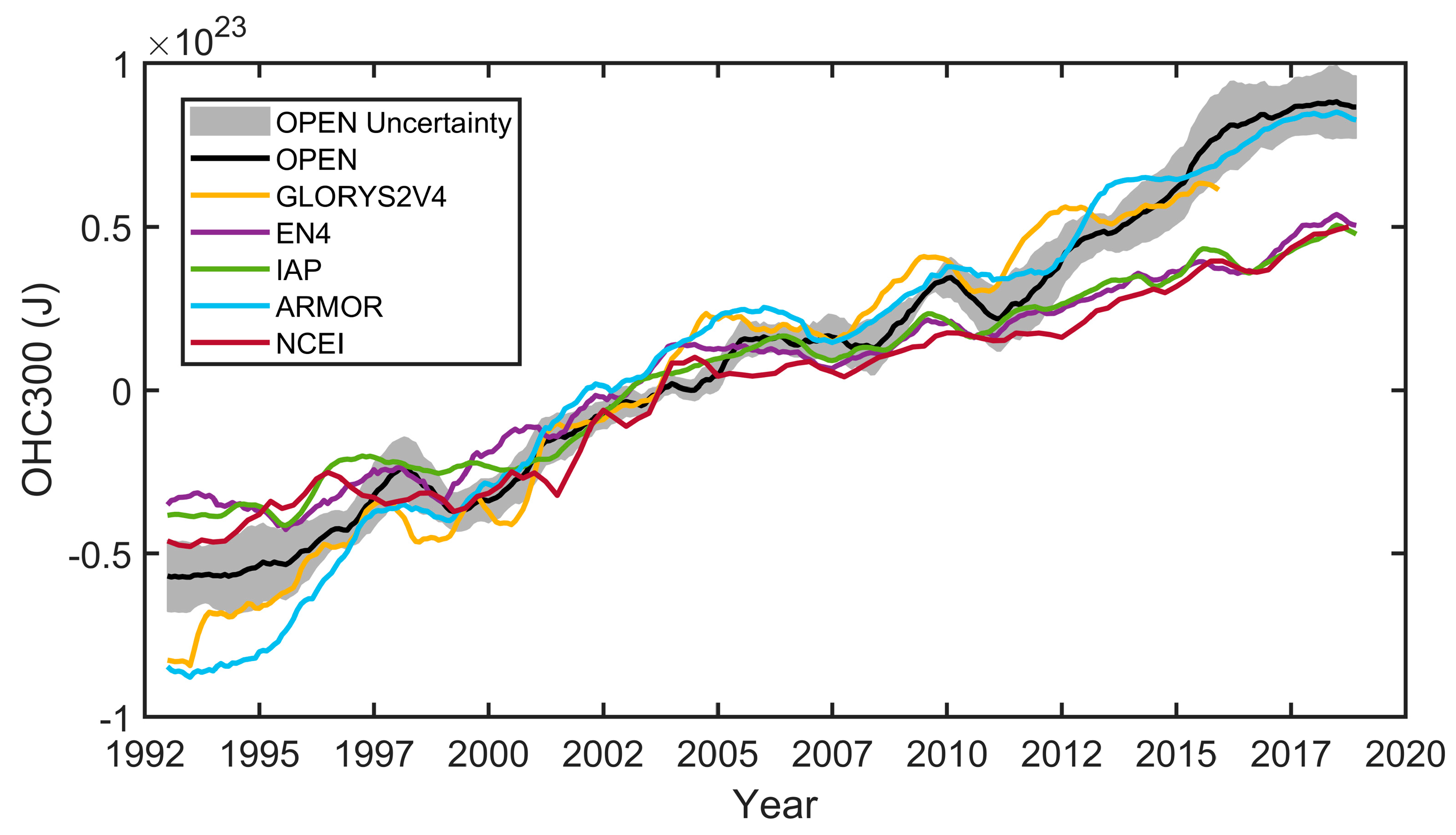
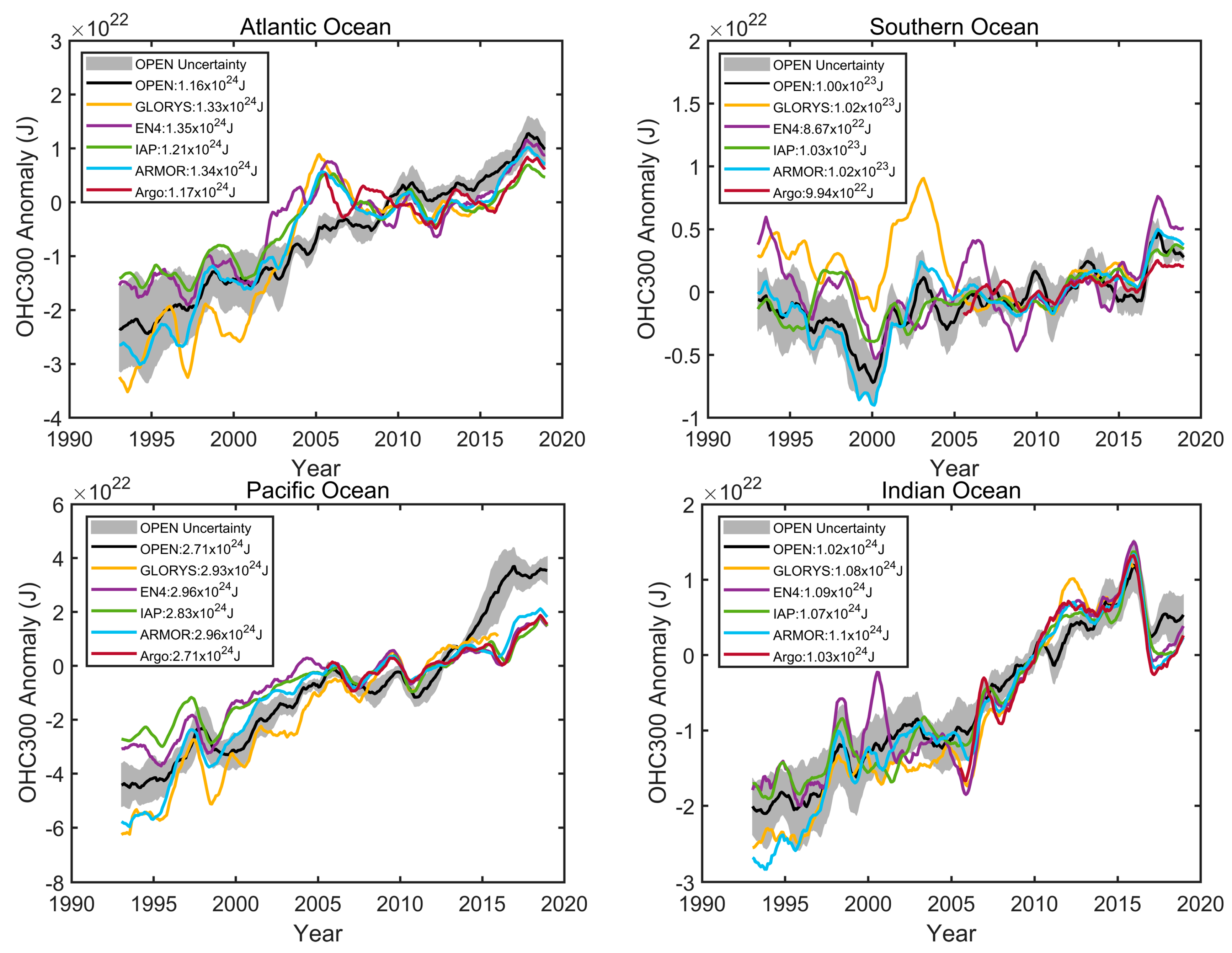


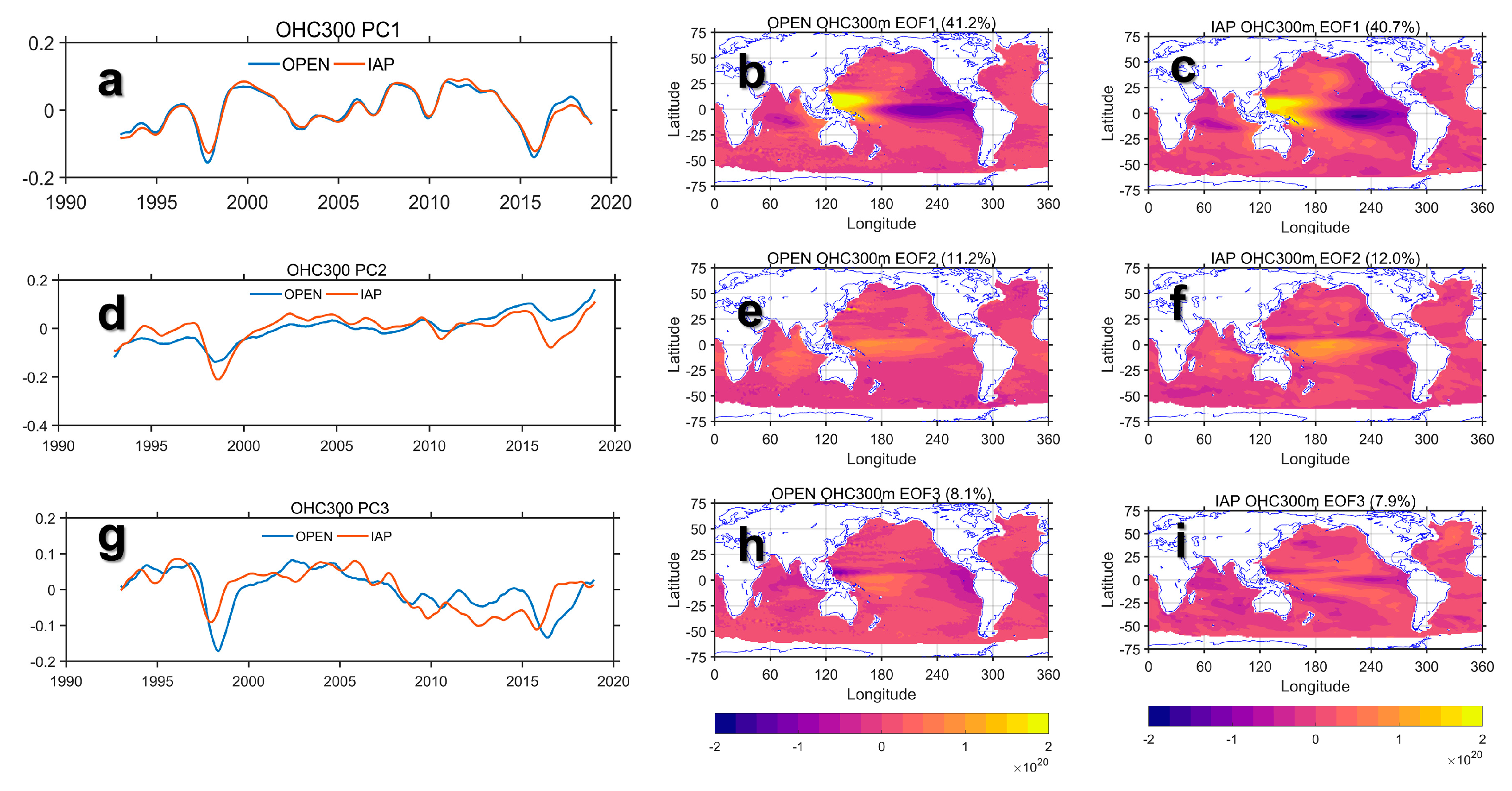
| Experiment # | Input Features | R2 (Case A/Case R) | RRMSE (Case A/Case R) |
|---|---|---|---|
| Case 1A, Case 1R | SSHASSTA | 0.6911/0.7096 | 0.3863/0.3788 |
| Case 2A, Case 2R | SSHASSTA DOY LON LAT | 0.7883/0.7972 | 0.3627/0.3400 |
| Case 3A, Case 3R | SSHASSTA SSWA | 0.7028/0.7155 | 0.3831/0.3788 |
| Case 4A, Case 4R | SSHASSTA SSWA DOY LON LAT | 0.7892/0.8030 | 0.3584/0.3375 |
| Case 5A, Case 5R | SSHASSTASSSA | 0.6387/0.7085 | 0.3952/0.3871 |
| Case 6A, Case 6R | SSHASSTASSSA DOY LON LAT | 0.6735/0.7923 | 0.4878/0.3526 |
| Case 7A, Case 7R | SSHASSTASSSA SSWA | 0.6374/0.7178 | 0.4078/0.3798 |
| Case 8A, Case 8R | SSHASSTASSSA SSWA DOY LON LAT | 0.7093/0.8057 | 0.4359/0.3318 |
| Depth | IAP | OPEN | EN4 | GLORYS2V4 | ARMOR3D |
|---|---|---|---|---|---|
| 1993–2010/1998–2015 | |||||
| 0–300 m | 3.74/3.73 | 5.34/5.47 | 3.71/3.44 | 6.90/6.05 | 7.34/5.56 |
| 0–700 m | 5.61/5.83 | 7.80/8.16 | 6.16/6.23 | 12.39/9.85 | 13.05/8.58 |
| 0–1500 m | 7.45/7.83 | 9.66/10.64 | 8.32/9.15 | 15.59/13.54 | 18.22/12.73 |
| 0–2000 m | 7.89/8.46 | 9.97/11.22 | 8.70/9.85 | 16.12/14.59 | 18.76/13.21 |
| Basin | IAP | OPEN | EN4 | GLORYS2V4 | ARMOR3D |
|---|---|---|---|---|---|
| 1993–2010/1998–2015 | |||||
| Indian Ocean | 0.89/1.45 | 1.13/1.36 | 0.74/1.36 | 1.21/1.73 | 1.38/1.49 |
| Pacific Ocean | 1.69/1.45 | 2.57/2.45 | 2.23/1.33 | 3.54/3.12 | 3.50/1.93 |
| Atlantic Ocean | 1.14/0.60 | 1.47/1.29 | 1.28/0.62 | 2.29/1.27 | 1.96/0.88 |
| Southern Ocean | −0.02/0.19 | 0.10/0.30 | −0.23/0.12 | −0.28/−0.18 | 0.11/0.37 |
© 2020 by the authors. Licensee MDPI, Basel, Switzerland. This article is an open access article distributed under the terms and conditions of the Creative Commons Attribution (CC BY) license (http://creativecommons.org/licenses/by/4.0/).
Share and Cite
Su, H.; Zhang, H.; Geng, X.; Qin, T.; Lu, W.; Yan, X.-H. OPEN: A New Estimation of Global Ocean Heat Content for Upper 2000 Meters from Remote Sensing Data. Remote Sens. 2020, 12, 2294. https://doi.org/10.3390/rs12142294
Su H, Zhang H, Geng X, Qin T, Lu W, Yan X-H. OPEN: A New Estimation of Global Ocean Heat Content for Upper 2000 Meters from Remote Sensing Data. Remote Sensing. 2020; 12(14):2294. https://doi.org/10.3390/rs12142294
Chicago/Turabian StyleSu, Hua, Haojie Zhang, Xupu Geng, Tian Qin, Wenfang Lu, and Xiao-Hai Yan. 2020. "OPEN: A New Estimation of Global Ocean Heat Content for Upper 2000 Meters from Remote Sensing Data" Remote Sensing 12, no. 14: 2294. https://doi.org/10.3390/rs12142294
APA StyleSu, H., Zhang, H., Geng, X., Qin, T., Lu, W., & Yan, X.-H. (2020). OPEN: A New Estimation of Global Ocean Heat Content for Upper 2000 Meters from Remote Sensing Data. Remote Sensing, 12(14), 2294. https://doi.org/10.3390/rs12142294










